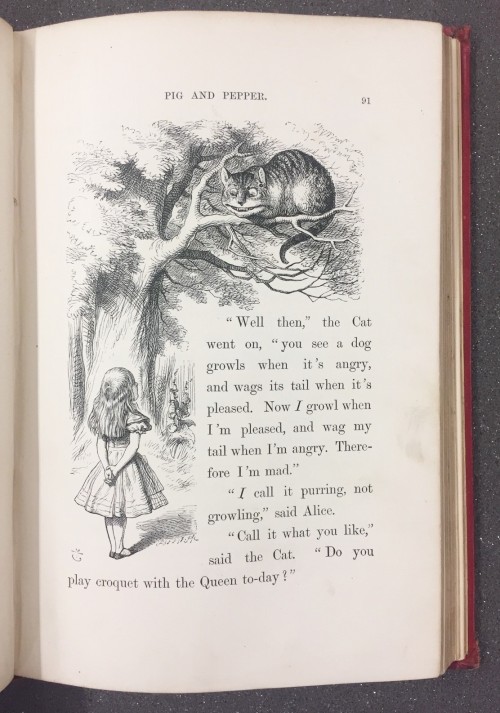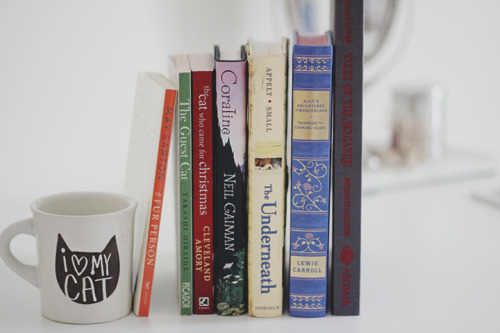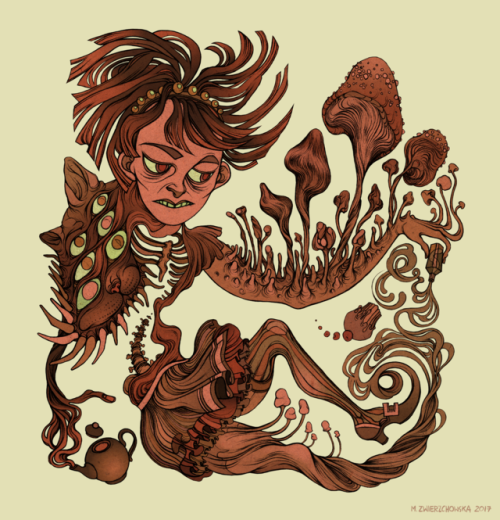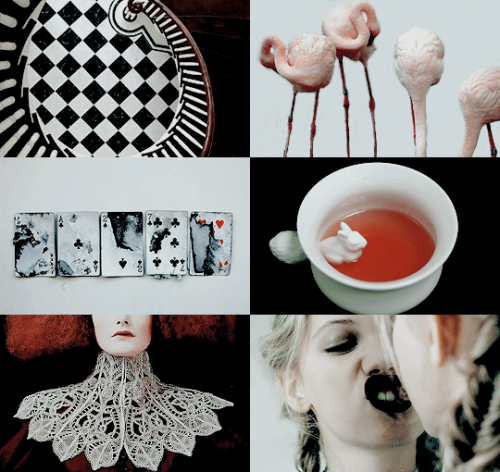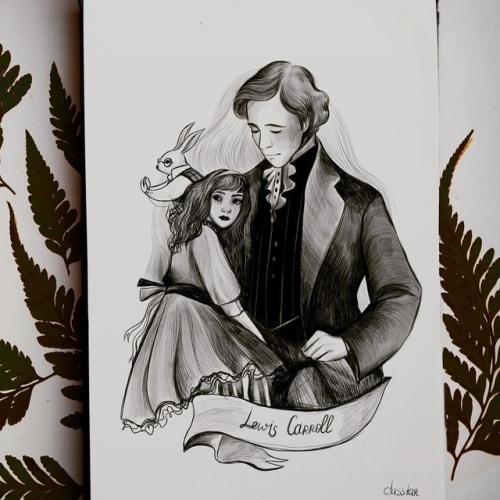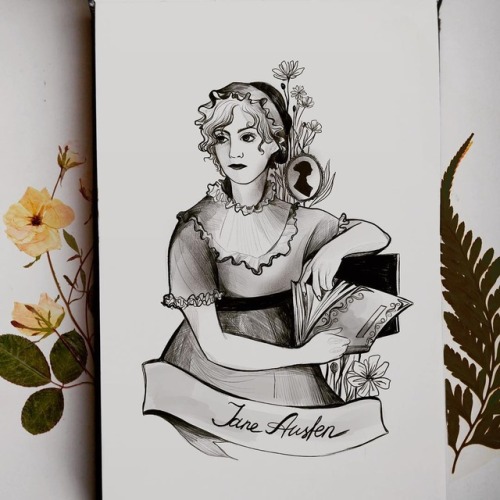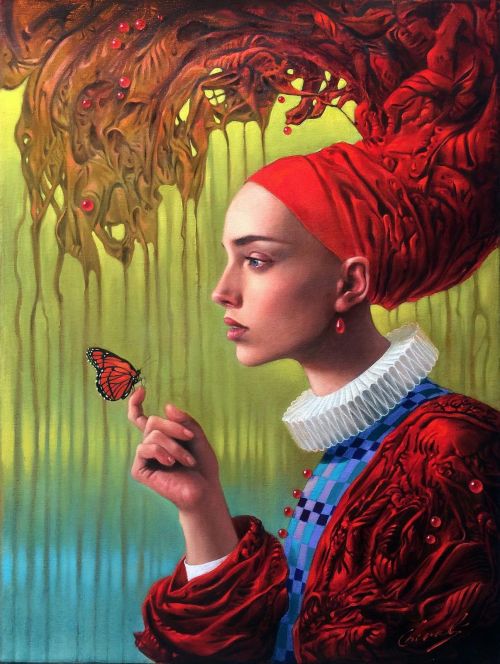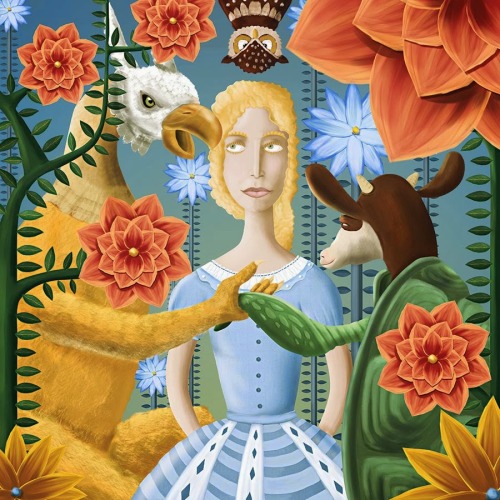#lewis carroll
“I wonder if the snow loves the trees and fields, that it kisses them so gently? And then it covers them up snug, you know, with a white quilt; and perhaps it says, "Go to sleep,darlings, till the summer comes again.”
Happy Birthday to illustrator and cartoonist Sir John Tenniel (1820-1914), born 200 years ago today (28 February), and perhaps best remembered for his illustrations in Lewis Carroll’s Alice’s Adventures in Wonderland (1865) and its follow-up novel Through the Looking-Glass and What Alice Found There (1871).
–
Lewis Carroll, Alice’s Adventures in Wonderland. London: Macmillan and Co., 1866, Alexander Turnbull Library, REng DODG Alic 1866.
Lewis Carroll, Through the Looking-Glass: and What Alice Found There. London: Macmillan and Co., 1872, Alexander Turnbull Library, REng DODG Alic 1872.
Post link

Inktober Día 23 -La casa del conejo
Antes de haberse acabado la mitad de la botella, se encontró con que su cabeza se apretujaba contra el techo, y tuvo que torcerla para no romperse el cuello. Se apresuró a dejar la botella, diciendo: «Ya es más que suficiente—Espero no seguir creciendo—Ya así como estoy, no puedo salir por la puerta—¡Ojalá no hubiera tomado tanto!»
Lewis Carrol: El hombre misterioso
Hoy se conmemora la muerte de Lewis Carroll, creador de la maravillosa historia de Alicia (Alice in wonderland) por la que hoy es famoso, pero además existen varios misterios que giran en torno a él.
Post link










HOW DISNEY USED A REAL MODEL TO DRAW ALICE IN WONDERLAND
Kathryn Beaumont (born 27 June 1938), the actor who voiced both Alice in Disney’s Alice in Wonderland and Wendy in Disney’s Peter Pan, also modeled for the animators. These photos show how much work was put into classical animation at the Disney studio.
Walt Disney chose Beaumont to be the voice of Alice when she was just ten years old. He chose her for the model of Alice. She was named a “Disney Legend” by the Walt Disney Company in 1998.
Made under the supervision of Walt Disney himself (1951), this film and its animation are often regarded as some of the finest work in Disney studio history, despite the lackluster, even hostile, reviews it originally received.
It gained popularity in the 1970’s due to the “drug” culture fandom at the time, it was released in 1974, and then again in 1981.
Today, it is not only considered the best animated film adaptation of Lewis Carrol’s novel but one of Disney’s greatest classics. { 1-10 }
I’ve lost count of the number of older works of fiction that some people refuse to take at face value. So many literary critics, when faced with an aspect of a classic book or play that they don’t like, will claim that it’s really a deconstruction or a satire, or that the author didn’t really want to write it that way, but reluctantly gave in to the mores of their time period. Whether it’s because the work is out of step with modern values, or because the tone is inconsistent, or because certain storylines play out differently than the critic wanted them to, or, very commonly, because the work is too romantic, too optimistic, etc., and not edgy and cynical enough, the critics cry “insincere author.”
We see this when people claim that Romeo and Juliet is really a satire or a deconstruction of a love story. Or when they claim that the ending of Wuthering Heights inconsistent with the rest of the book, and probably wasn’t the original ending Emily Brontë wrote, or that Jane Eyre’s happy ending is supposed to ring false and hollow. Or that the ending of Little Women is another false happy ending that’s actually supposed to be disappointing. Or many other examples.
Now I’ve seen this thinking applied to Alice in Wonderland too. Namely to the sentimental poems and gentle real-world scenes that frame both of the two books: the poem “All in the golden afternoon” that opens Alice’s Adventures in Wonderland and the reverie of Alice’s sister that ends the book, and Through the Looking-Glass’s framing poems “Child of the pure unclouded brow” and “A boat beneath a sunny sky” and its opening and closing scenes of Alice playing with her kitten.
I’ve now seen two people (composer Unsuk Chin in her notes on her opera adaptation, and an essay writer whose name I’ve forgotten) argue that these poems and scenes are tonally inconsistent with the rest of the text, and that they’re much more conventionally Victorian in their sentimentality and idyllic portrait of childhood than Alice’s dream adventures are in all their surrealism, humor, dark edges and cultural satire. Unsuk Chin wrote that Carroll was probably forced to give the books a conventional, sentimental framing, or else they would have been too radical for the era, and she suggested that he probably would have written very different opening and closing scenes if he had his own way. I also found an essay targeting the opening and closing poems, which suggested that they should be read as satirical, because their sentimental tone and their framing of the stories as simple, wondrous fairy tales for innocent children is so out-of-step with the books’ actual tone.
That’s an interesting idea that I had never considered before. I always have noticed that difference in tone between Alice’s adventures and the framing poems and scenes. But I’ve still always assumed that the framing sentimentality was sincere on Carroll’s part, and that this was part of the books’ complexity. The idea that it might really be satire never crossed my mind until now.
But to be honest, I still lean toward thinking they’re sincere. In the first place, Carroll’s satirical poems within Alice’s dreams (e.g. “How doth the little crocodile” and “You are old, Father William”) are obviously satire. Gleeful, wicked satire of the popular moralizing poems of the day. Not poems so subtly satirical that most people would think they were straight examples of the sentimental Victorian verses they parody. Secondly, in 1887, Carroll wrote an article called “Alice on the Stage,” in which he gave detailed descriptions of each of the book’s characters and what he thought of their portrayals in a recent stage adaptation. His description of Alice herself is very similar in tone to the framing poems and the affectionate reverie of the older sister at the end of the first book. He waxes very sentimentally about her loving, gentle, courteous nature, and of the innocence, joy, and wonderment of childhood that she embodies. Again, there’s a bit of a disconnect between the angel-child he describes and the character he actually wrote – is this girl, “loving as a dog and gentle as a fawn,” the same one who kicked Bill the Lizard out of the chimney and who remarked “I don’t think it’s a pity at all” when told that the Duchess was sentenced to death? But unless he meant this article as satire too, I can’t imagine after reading it that the books’ openings and endings are insincere in their tenderness.
Besides, as I pointed out, commentators are always trying to explain away aspects of classic literature that they don’t like by saying “It was meant as satire” or “The author was forced to write this by the mores of the time period.”
Still, the idea that the sentimental poems and framing scenes might have been meant as satire, or that they might have been concessions to Victorian taste so the books wouldn’t seem too radical, is worthwhile to consider. They are very different in tone from the surreal and satirical stories they frame, after all. I might personally view that difference as just a part of the books’ complexity (and as reflecting the complex, enigmatic character of the man who wrote them), but it’s worth exploring from every possible angle.

so i said there were 3 orwell references in this diorama that i cld spot
the first & namesake is on the two tins of tea :
pls note that i cannot make out the first name of the tea importers firm & have not yet been able to determine if its a real historic brand or not , google turning up no matches for an “and appleby” line from the 19th c on the steampunk / reenactment / collectibles fronts (x)
however the look of them is very authentic , the art style and colors are exactly in line w actual historic advertising & marketing materials from circa 1890 - 1910
& the symbolism of the adapted heraldry of great britain is quite in keeping w a brand aspiring to be awarded the honor of a royal appointment – or tryin to make casual shoppers think they already had one , hah !
but while to the vast majority of viewers this will symbolize at first & likely also 2nd glance ALICE IN WONDERLAND & THROUGH THE LOOKING GLASS bc tea –> parties (x) + lion & unicorn “were fighting for the crown” (x) = lewis carroll by default
there is something else , an obscure but super important essay by orwell from 1941
ie in the height of the blitz , during the battle of britain , but before the US had been bombed by the axis
after he & his wife had got back from the debacle of the spanish civil war
& it is called THE LION & THE UNICORN(x)
& begins w bombs falling from airplanes

& is a discussion of britain as a society & a culture & a govt as well as a changing one faced w a choice of directions imposed by war ( agn )
& in it , in the course of talking abt british culture , the “the nice cup of tea” - a subject so dear to his heart he wrote a whole other essay after the war on the right way to make tea (x) called just that -
& also the english love of flowers
all of which we see above in the CRIMSON PEAK display along w a chatelaine , a ring of keys - the key bein a symbol that features significantly in guillermo del toros previous films , both DEVILS BACKBONE & PANS LABYRINTH in literal / traditional fashion , & in more arcane modes in the HELLBOY films & CRONOS –& in BLADE 2 as in PACIFIC RIM more futuristic ones , but a key is a key if it be a puzzle-piece of metal or wood or a carefully guarded number sequence , or the DNA sequence of a member of the royal blood
–the key also oc simultaneously a longtime symbol of christianity , used heraldically esp by the church of rome , being associated w st peter the gatekeeper of heaven & equally of hekate the guardian of the crossroads of life & death , used in one of the most famous rites of that goddess long before christianity–
–one of the keys appears to have a skull finial altho the photo is not as high res as i wld like–
the moss-green doily under the tea service keys & morning paper bein significant @ least for its color as well as its floral symbols
but then there is the paper itself & upon closest examination i see that it does not say that LADY BEATRICE ALEXANDRA SHARPE ( ! ! ! ) was the victim , but that someone connected tp her by an “of” was slain in their bath
so the plot thickens
bc there is a ton of stuffs goin on uncovered via this orwell link
& mainly it hotwires directly to discworld
bc tell me if this does not speak muchly of ankh-morpork as described in those books ??
But here it is worth noting a minor English trait which is extremely well marked though not often commented on, and that is a love of flowers. This is one of the first things that one notices when one reaches England from abroad, especially if one is coming from southern Europe. Does it not contradict the English indifference to the arts? Not really, because it is found in people who have no aesthetic feelings whatever. What it does link up with, however, is another English characteristic which is so much a part of us that we barely notice it, and that is the addiction to hobbies and spare-time occupations, the privateness of English life. We are a nation of flower-lovers, but also a nation of stamp-collectors, pigeon-fanciers, amateur carpenters, coupon-snippers, darts-players, crossword-puzzle fans. All the culture that is most truly native centres round things which even when they are communal are not official - the pub, the football match, the back garden, the fireside and the ‘nice cup of tea’. The liberty of the individual is still believed in, almost as in the nineteenth century. But this has nothing to do with economic liberty, the right to exploit others for profit. It is the liberty to have a home of your own, to do what you like in your spare time, to choose your own amusements instead of having them chosen for you from above. The most hateful of all names in an English ear is Nosey Parker. It is obvious, of course, that even this purely private liberty is a lost cause. Like all other modern people, the English are in process of being numbered, labelled, conscripted, ‘co-ordinated’. But the pull of their impulses is in the other direction, and the kind of regimentation that can be imposed on them will be modified in consequence. No party rallies, no Youth Movements, no coloured shirts, no Jew-baiting or ‘spontaneous’ demonstrations. No Gestapo either, in all probability.
But in all societies the common people must live to some extent against the existing order. The genuinely popular culture of England is something that goes on beneath the surface, unofficially and more or less frowned on by the authorities. One thing one notices if one looks directly at the common people, especially in the big towns, is that they are not puritanical. They are inveterate gamblers, drink as much beer as their wages will permit, are devoted to bawdy jokes, and use probably the foulest language in the world. They have to satisfy these tastes in the face of astonishing, hypocritical laws (licensing laws, lottery acts, etc. etc.) which are designed to interfere with everybody but in practice allow everything to happen. Also, the common people are without definite religious belief, and have been so for centuries. The Anglican Church never had a real hold on them, it was simply a preserve of the landed gentry, and the Nonconformist sects only influenced minorities. And yet they have retained a deep tinge of Christian feeling, while almost forgetting the name of Christ. The power-worship which is the new religion of Europe, and which has infected the English intelligentsia, has never touched the common people.
beyond that but also bc that there is a great deal in this essay which is politically & socially relevant despite the changed times – esp the bit abt bein simultaneously exhorted to save for the war effort WHILE simultaneously exhorted to shop shop shop in the name of patriotism
something anyone who was a conscious adult i n 2002 will remember bein revolted by , or even just an alert teen of which there were many
even if there is a good deal i wld disagree w from my distant & hindsighted perspective , like for one i think orwell –yes , old george orwell himself ! ! is far more sentimental abt england & his countrymen than sir terry , esp when it comes to matters of war & empire & militarism
that ankh-morporkians happily ranting against “johnny klatchian” & “the cheese-eaters of quirm” are more true to the spirit of john bull & that eric blair is FAR too soft on the raj harsh on it tho he was in the light of his own experience in burma (x) & i think george monbiot cld have taught him a few things (x) or put them in better perspective @ least (x) –& i do wonder if there isnt also some cryptic connection w luc besson makin his last big movie abt a burmese protestor
bc here is the kicker
i have been goin thru all the watch books now w a close reading & a watchful eye for symbols & references that i might have missed or thought just a joke before
& MONSTROUS REGIMENT is not the first SHARPES RIFLES fanfic pratchett did altho it is more obv
& the earlier SHARPE fanfic / fixfic is also his LES MIS fanfic / fixfic
but also a very grim BATMAN fic –grimmer than anything alan moore or frank miller dared dream up – is NIGHT WATCH indeed
bc carcer is an evil vimes doppelganger & thus the joker to vimes noir batman who operates on the very broken jagged edge of the law in this one , seeking out the dangerous answer WHAT IS THE LAW ?? IS ‘ORDER’ FOUND IN OBEYING ORDERS – OR IN FOLLOWING THE ESSENCE OF THAT LAWFULNESS??
but it was also a dark & prescient take on the current reality of the War on Some Nouns WHICH IS STILL GOING ON
& CARCER IS A VERSION OF SGT OBEDIAH HAKESWILL played w vicious aplomb by the late great pete postlethwaite AKA THE NEMESIS OF SHARPE WHO JOINED UP FOR THE LOOTING
& if there is any doubt that sam vimes is richard sharpe HE EVEN MAKES A NAME JOKE ON IT TO LORD RUST ! ! !
however in the course of all this collision of memes pratchett did something else huge
bc he took the timelords , that most english of inventions in entertainment , & turned them into the MI-5 of the bondverse , that other oh so english of entertainments
& made them both as unenglish as cld be TIMEBENDERS AHEAD OF TIME & also lightly made them part of UNCLE bc entrance thru a clothes shop here in their 3rd outing
its a huge subversion & of both universes , bc the bondverse is all abt “ENGLAND PREVAILS” defending the neoraj of the angloamerican pax thru strength
& the timelords are all abt the status quo in the name of benevolent handsoffery but rly to protect their privilege until it all goes blooey - except for the erratic champion-but-also-tourist the doctor
& in pratchetts hands the order of the history monks is defending reality from exactly the sort of authority figures that orwell criticized in his praise of toads & hares (x)
I think that by retaining one’s childhood love of such things as trees, fishes, butterflies and - to return to my first instance - toads, one makes a peaceful and decent future a little more probable, and that by preaching the doctrine that nothing is to be admired except steel and concrete, one merely makes it a little surer that human beings will have no outlet for their surplus energy except in hatred and leader worship.(…) The atom bombs are piling up in the factories, the police are prowling through the cities, the lies are streaming from the loudspeakers, but the earth is still going round the sun, and neither the dictators nor the bureaucrats, deeply as they disapprove of the process, are able to prevent it.
but it was in FIFTH ELEPHANT that del toro found the key for makin the lost daughter & the unsaved child & the unwanted orphan ALL THE SAME SOLAR WOLF-CHAMPION FIGHTING THE ELDER GODS GENERATION AFTER GENERATION
& it is hella grim in its lead for the alchemy
bc there is a girl & a shoe in that tale as well but her story didnt have a happy ending
& also i know how it too is a bondverse fic by retconnection now
not just bc NIGHT WATCH made sam vimes into james that time round
but bc of yes PACIFIC RIM
oh & there are also evil & unredeemed versions of hermann & newt in NIGHT WATCH
even as discworlds hakeswill is defeated in it
bc this is not the SHARPE fanfic w the folksongs in it – no hagman & harris except on the barricades as the multitude ( see how they rise up … )
& as there are good ( or good-ish ) versions of them in UNSEEN ACADEMICALS
but that will have to go in another post bc rl stuff calls
but yes the great game they are playing has a point , the story isnt idle diversion @ least on the side of team resistance
& THE CAKE WAS ALWAYS A LIE – & orwells essay goes into that in quite some detail for its brevity
read in 2019. alice’s adventures in wonderland by lewis carroll
alice had begun to think that very few things indeed were really impossible.
Post link
This post was written by Lyonas Xu, an intern from the Classics Department
Recently, I have been wondering how many people are suffering from a miserable life like I do. Sleeping or staring at the ceiling to kill the time, while this coronavirus grounding everyone with a lethal excuse. Though I am physically restrained, my mind is free, daydreaming to wherever I wish. Speaking of daydreams, we all know the mistress of this specialty who unveiled a wondrous dreamland to the world—Alice, the most remarkable character designed by Lewis Carroll (or specifically, Charles Lutwidge Dodgson).
Alicia in Terra Mirabili, is the Latin translation of Alice in Wonderland. The first Latin version of this worldly renowned childhood’s book was translated by Canadian translator Clive Carruthers and published in 1964. It is not modern scholars’ first attempt to translate English classics into Latin, but this is definitely one of the most delightful ones. Just think about reviving both the wonderland characters and an ancient language—what a spark they light!

Beginning with the book cover (above), an exquisite illustration of the iconic figure in wonderland, the white rabbit, is embossed in golden color. I was captivated by the delicacy of the cover already, but the inner artworks are on another level. For example, the picture adjacent to the title page (right) depicts the courtroom in wonderland, with all sorts of living things. The appearances of the king and queen of hearts resemble their classic designs in the playing cards and the readers can even tell the “flatness” of the attendant’s garment at the bottom left.

Another notable setup is the end papers (left), which are printed with a mind-map of Alice’s adventure. Following the thread and starting with the upper right corner, there are “initium somnii” (the beginning of the dream), “cuniculi cavum” (the rabbit hole), “stagum lacrimarum” (the pool of tears) and so forth. Although the “index capitum” (right), the table of contents (distinct from the mind-map), is provided by Carruthers, I personally enjoy the game-board-like one, which is more playful as well as enables its readers to easily connect the Latin title and the picture aside.
I never expect quarantine to be interesting, but neither does it mean I will surrender to boredom. Surely, I can find great pleasure through spending time with Alicia and her terra mirabili!
Sources:
Carroll, Ludovici. Alicia in Terra Mirabili. Translated by Clive Harcourt Carruthers, St Martin’s Press, 1964.
Herald, Times. “Alicia in Terra Mirabili.” Washington Post, 16 October 1964, p. A20.
Schnur, Harry C.. Review of Alicia in Terra Mirabili, liber notissimus latine redditus ab eius fautore vetere gratoque, translated by Clive Harcourt Carruthers. The Classical Journal, May 1965, p. 378.
“- Gatinho de Cheshire (…) Poderia me dizer, por favor, que caminho devo tomar para ir embora daqui?
- Isso depende muito de para onde quer ir - responder o Gato.
- Para mim, acho que tanto faz… - disse a menina.
- Nesse caso, qualquer caminho serve - afirmou o Gato.
- … contanto que eu chegue a algum lugar - completou Alice, para se explicar melhor.
- Ah, mas com certeza você vai chegar, desde que caminhe bastante.
- Mas eu não quero me meter com gente louca - ressaltou Alice.
- Mas isso é impossível - disse o Gato. - Porque todo mundo é meio louco por aqui. Eu sou. Você também é.
- Como pode saber se sou louca ou não? - disse a menina.
- Mas só pode ser - explicou o Gato. - Ou não teria vindo parar aqui.
Alice achou que isso não provava nada. No entento, continuou:
- E como você sabe que é louco?
- Para começo de conversa - disse o Gato - um cachorro não é louco. Concorda?
- É, acho que sim - disse Alice.
- Pois bem… - continuou o Gato. - Você sabe que um cachorro rosna quando está bravo e abana o rabo quando está feliz. Mas eu faço o contrário: eu rosno quando estou feliz e abano o rabo quando estou bravo. Portanto, eu sou louco.”
Post link



